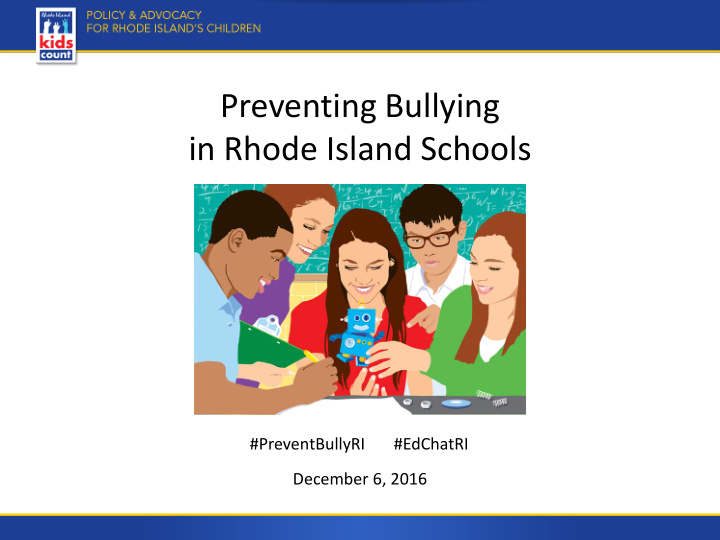



Preventing Bullying in Rhode Island Schools #PreventBullyRI #EdChatRI December 6, 2016
Special thanks to for its support of this Issue Brief 2
Defining Bullying Behavior that is aggressive, is carried out repeatedly and over time, and occurs in an interpersonal relationship where a power imbalance exists. 3
Statewide Bullying Policy • In 2011, the Rhode Island General Assembly passed the Safe Schools Act. • The Rhode Island Department of Education implemented the Statewide Bullying Policy on June 30, 2012. • Reports of bullying and responses to bullying incidents are tracked at the school level. 4
Who Experiences Bullying? • Incidents of bullying can be experienced by children of any age group. • Children can be involved in bullying incidents as a bully, victim, bystander, bully-victim or poly- victim. • Consequences of involvement in bullying vary depending on how a child is involved. 5
Students Who Report Being Bullied 6
Race and Ethnicity 7
Gender 8
LGBT • In the U.S., LGBT youth report higher rates of bullying incidents than peers. • Nationally, half (51%) of LGBT youth report having been verbally harassed in school, compared to 25% of their non-LGBT peers. • In 2015, 20% of Rhode Island high school students who identify as lesbian, gay, or bisexual (LGB) reported being bullied on school property. 9
Youth with Disabilities • Students with disabilities are overrepresented in the bullying dynamic. • Nationally, students with disabilities are up to 1.5 times more likely to be bullied than youth without disabilities. • In 2015 in Rhode Island, 25% of high school students who had been bullied on school property reported having a long term emotional problem or learning disability. 10
Youth who are overweight • Children who are overweight or obese are at risk for experiencing weight-based bullying, victimization and bias. • In Rhode Island in 2013, 12% of middle school and 12% of high school students reported being bullied because of their weight. 11
Reporting NA indicates that community has no school at that level. 12
School Climate 13
Bullying Prevention Programming and Best Practices • Olweus Bullying Prevention Program (OBPP) • Positive Behavioral Interventions and Supports (PBIS) • No Bully • Restorative Justice 14
Recommendations • Policies and Data Collection: – Continue to implement and publicly track evidence-based anti-bullying laws and policies at all levels. – Choose school climate as an accountability measure under the federal 2015 Every Student Succeeds Act (ESSA). 15
Recommendations • Best Practices for Schools: – School districts should implement evidence-based bullying prevention training for all staff who regularly work with students and develop benchmarks to evaluate effectiveness. – School social workers should assess students for PTSD, depression, and suicidal ideation/behaviors when students are involved in bullying situations. – Adopt trauma-informed positive school climate practices rooted in national research. 16
Recommendations • Targeted Interventions: – Schools and communities should explore programmatic opportunities for more specific vulnerable populations. – Schools and communities should implement evidence-based programs to address stigma- and bias-based bullying behavior. 17
Recommendations • School and Community Engagement: – Ensure that all adults who interact with students are involved in bullying prevention and intervention efforts. – Explore opportunities for peer-led bullying prevention programming at the school and community levels. 18
Preventing Bullying in Rhode Island Schools #PreventBullyRI #EdChatRI December 6, 2016
Pawtucket School District No Bully Examples No Bully workshop Cunningham ES No Bully Peace Summit
Bullying Prevention in Washington County Thomas DiPaola, PhD Washington County Coalition for Children; Johnson & Wales University, Educational Leadership Program Patrick Cozzolino, LICSW Westerly Middle School
1. Raise Community Awareness Conduct trainings for parents, community groups, and area after- school/camp staff Use literature to promote/reinforce positive responses of peers and adults
Distributed toolkits to 9 middle schools & 11 public libraries with recommended books and reading lists funded by the Women’s Club of South County Cross Mills Library Book Club
Encourage publication of student editorials Organize community awareness events like Chalk It Up Against Bullying
2. Start Young Start early promoting social emotional skills 1. Created Planting the Seeds of Kindness in Preschoolers: Lessons & Activities Using Picture Books 2. Conducted a 2-part training for area early care & education providers
3. Encourage Evidence-Based Bullying Prevention Programming in Schools Partner with schools to implement the Olweus Bullying Prevention Program (OBPP)
4 Key OBPP Components Individual – On the Spot Interventions Classroom – Regular classroom meetings School – School Rules/Protocols Community – Moving efforts beyond school walls
Empowering Peers
Creative Ways to Engage Youth Themes: Hero, Random Acts of Kindness, etc. Storytelling Assembly and Writing Workshop Contests: Chant, Poster, Editorial, Video One Book/One School – “Wonder” Pink Shirt Day Celebrations Mix It Up at Lunch
Wall of Intolerance
Final Thought “It is vital that when educating our children’s brains that we do not neglect to educate their hearts.” ~Dalai Lama
Preventing Bullying in Rhode Island Schools #PreventBullyRI #EdChatRI December 6, 2016
Recommend
More recommend